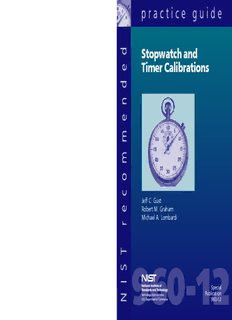
Timer Calibrations Stopwatch and - ANSI-ASQ National PDF
Preview Timer Calibrations Stopwatch and - ANSI-ASQ National
Stopwatch and Timer Calibrations Jeff C. Gust Robert M. Graham Michael A. Lombardi 960-12 Special Publication May 2004 960-12 NIST Recommended Practice Guide Special Publication 960-12 Stopwatch and Timer Calibrations Jeff C. Gust Quametec Corporation Robert M. Graham Sandia National Laboratories Michael A. Lombardi National Institute of Standards and Technology Physics Laboratory May 2004 DEPARTMENTOFCOMMERCE UNITEDSTATESOFAMERICA U.S. Department of Commerce Donald L. Evans, Secretary Technology Administration Phillip J. Bond, Under Secretary for Technology National Institute of Standards and Technology Arden L. Bement, Jr., Director i ◆ Stopwatch and Timer Calibrations Certain commercial entities, equipment, or materials may be identified in this document in order to describe an experimental procedure or concept adequately. Such identification is not intended to imply recommendation or endorsement by the National Institute of Standards and Technology, nor is it intended to imply that the entities, materials, or equipment are necessarily the best available for the purpose. National Institute of Standards and Technology Special Publication 960-12 Natl. Inst. Stand. Technol. Spec. Publ. 960-12 57 pages (May 2004) CODEN: NSPUE2 U.S. GOVERNMENT PRINTING OFFICE WASHINGTON: 2004 For sale by the Superintendent of Documents U.S. Government Printing Office Internet: bookstore.gpo.gov Phone: (202) 512–1800 Fax: (202) 512–2250 Mail: Stop SSOP, Washington, DC 20402-0001 ii ◆ Foreword FOREWORD Stopwatch and timer calibrations are perhaps the most common calibrations performed in the field of time and frequency metrology. Hundreds of United States laboratories calibrate many thousands of timing devices annually to meet legal and organizational metrology requirements. However, until now, no definitive text has existed on the subject. This NIST Recommended Practice Guide was created to a fill a gap in the metrology literature. It assists the working metrologist or calibration technician by describing the types of stopwatches and timers that require calibration, the specifications and tolerances of these devices, the methods used to calibrate them, and the estimated measurement uncertainties for each calibration method. It also discusses the process of establishing measurement traceability back to national and international standards. iii ◆ Stopwatch and Timer Calibrations iv ◆ Acknowledgments ACKNOWLEDGMENTS The authors thank the following individuals for their extremely useful suggestions regarding this manuscript: Georgia Harris and David Smith of NIST, Ross Andersen of the New York Bureau of Weights and Measures, Jim Jenkins of Quametec Corporation, and Warren Lewis and Dick Pettit of Sandia National Laboratories.* *Sandia is a multiprogram laboratory operated by Sandia Corporation, a Lockheed Martin Company, for the United States Department of Energy’s National Nuclear Security Administration under Contract DE-AC04-94AL85000. v ◆ Stopwatch and Timer Calibrations vi ◆ Table of Contents TABLE OF CONTENTS List of Figures.....................................................................................ix List of Tables........................................................................................x 1. Introduction to Stopwatch and Timer Calibrations..........1 1.A. The Units of Time Interval and Frequency................1 1.B. A Brief Overview of Calibrations ...............................3 1.C. Traceability and Coordinated Universal Time (UTC)...................................................................5 2. Description of Timing Devices that Require Calibration..............................................................9 2.A. Stopwatches ................................................................9 2.A.1. Basic Theory of Operation ............................11 2.B. Timers..........................................................................13 2.C. Commercial Timing Devices.....................................14 3. Specifications and Tolerances..........................................15 3.A. Interpreting Manufacturer's Specifications..............15 3.B. Tolerances Required for Legal Metrology ...............19 4. Calibration Methods...........................................................21 4.A. Direct Comparison Method.......................................21 4.A.1. References for Direct Comparison Method......................................21 4.A.2. Calibration Procedure for Direct Comparison Method...........................25 4.B. Totalize Method...........................................................27 4.C. Time Base Method......................................................29 vii ◆ Stopwatch and Timer Calibrations 5. Measurement Uncertainty.................................................35 5.A. Uncertainties of Direct Comparison Method .........35 5.A.1. Uncertainty of the Traceable Time Interval Reference.................................35 5.A.2. Uncertainty Due to Human Reaction Time.................................................37 5.A.3. Device Under Test (DUT) Resolution Uncertainty..................................39 5.A.4. Uncertainty Analysis......................................39 5.B. Uncertainties of Totalize Method .............................41 5.B.1. Uncertainty of the Frequency Input..............41 5.B.2. Uncertainty Due to Human Reaction Time.................................................41 5.B.3. Uncertainty Due to the Counter....................43 5.B.4. Device Under Test (DUT) Resolution Uncertainty..................................44 5.C. Uncertainties of Time Base Method........................45 5.D. Uncertainty Analysis of Using a Calibrated Stopwatch to Calibrate Another Device..................45 5.E. Adequacy of Calibration Method to Meet the Required Uncertainty ................................46 Appendix A: Calibration Certificates.....................................49 References.................................................................................51 viii
Description: